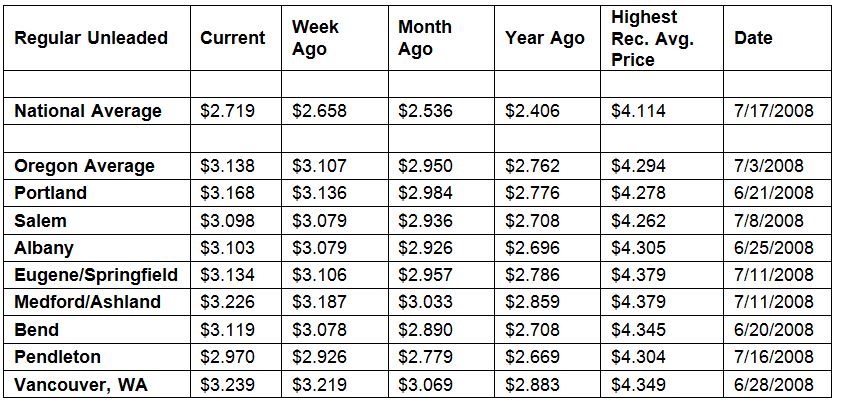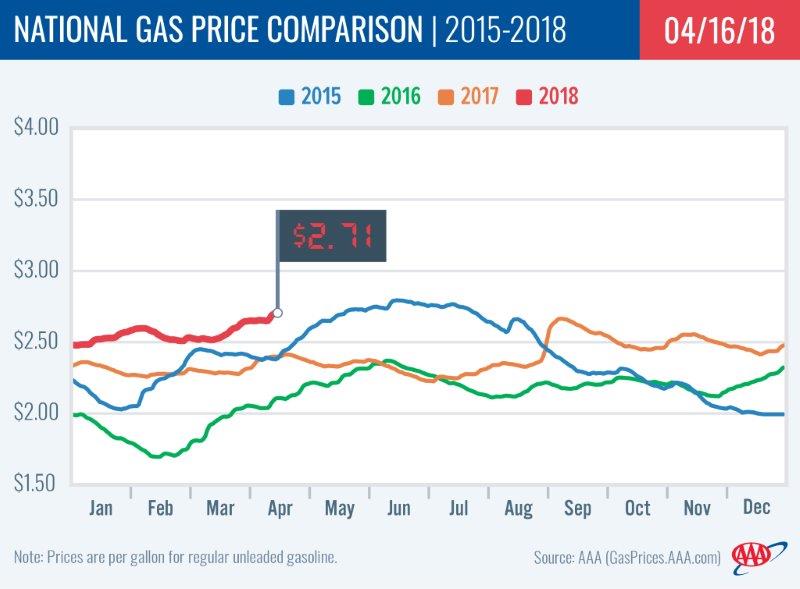PORTLAND, Ore., – Gas prices are at their highest levels in nearly three years and continue to climb in all 50 states. For the week, the national average for regular jumps six cents to $2.72 a gallon while the Oregon average adds three cents to $3.14. Both averages are at their highest prices since July 2015. The Oregon average remained above $3 a gallon that year from May 8 through August 16.
“The driving forces behind climbing pump prices are higher crude oil prices, unrest in the Middle East, and strong demand for gasoline in the U.S. and around the world,” says Marie Dodds, public affairs director for AAA Oregon/Idaho. “AAA projects retail gas prices will climb another 5 to 20 cents this spring, but the national average isn’t expected to top $3 a gallon. The Oregon average has been above $3 a gallon this year since March 22.”
AAA forecasts that 88 million American families will vacation this summer, with two-thirds of those planning to drive to their destinations. “Travelers should plan now for higher gas prices for their summer road trips,” adds Dodds.
All 50 states and the District of Columbia report week-over-week increases. The largest jumps are in Indiana (+11 cents) and Colorado (+11 cents). Oregon had one of the smallest weekly increases of 3 cents, which is the 48th largest in the country.
All 50 states and the District of Columbia also have higher prices than one month ago. The national average is 18 cents more and the Oregon average is 19 cents more than a month ago. This is the 20th-largest monthly increase in the country. Utah (+55 cents) and Idaho (+43 cents) have the largest monthly gains.
The West Coast still has the most expensive gas prices in the nation with six of the top ten states in this region. Hawaii tops the list, followed by California, Washington, Alaska, Nevada and Oregon. Oregon drops to sixth most expensive after 10 weeks at fifth. This week Idaho becomes the seventh state to have an average of $3 a gallon.
According to the U.S. Energy Information Administration’s (EIA) latest report for the week ending on April 6, gasoline inventories on the West Coast fell by 600,000 bbl to 31.4 million bbl. This draw marks the third consecutive draw in the region. Although inventories continue to drop, they are now approximately 1.5 million bbl higher than they were at this time in 2017.
The nation’s cheapest markets are Oklahoma ($2.44) and Arkansas ($2.45). For the 37th week in a row, no states have an average below $2.
Drivers in all 50 states and the District of Columbia are paying are paying more than a year ago to fill up. The national average is 31 cents more and the Oregon average is 38 cents more than a year ago. This is the eighth-largest yearly increase in the country. Utah has the greatest year-over-year increase of 55 cents; California is second at 54 cents; Hawaii is third at 50 cents; and Idaho is fourth at 50 cents.
Oil Market Dynamics
Crude oil prices have climbed to their highest prices since December 2014 due to concerns about tensions in the Middle East following the air strikes in Syria. Although Syria is not a major oil producer, tension in the country could ripple to other countries in the region and restrict global oil supply flows.
In its latest report, data from the EIA shows domestic crude production in the U.S. hit a new record high of 10.53 million b/d. The increased output led crude storage levels to grow by 3.3 million bbl to 428.6 million bbl. With Baker Hughes, Inc. reporting that the U.S. added seven oil rigs last week – bringing the total to 815 – crude production in the U.S. is likely to continue growing.
At the close of Friday’s formal trading session on the NYMEX, WTI increased 32 cents to settle at $67.39. At the close of Monday’s formal trading session on the NYMEX, WTI lost $1.17 to settle at $66.22. Today crude is trading around $66, compared to $65 a week ago. Crude prices are up about seven percent in the last month and are about $13 more per barrel than a year ago.
Drivers can find current gas prices along their route with the free AAA Mobile app for iPhone, iPad and Android. The app can also be used to map a route, find discounts, book a hotel and access AAA roadside assistance. Learn more at AAA.com/mobile.
Diesel
For the week, the national average gains four cents to $3.01 a gallon. Oregon’s average jumps six cents to $3.25. A year ago the national average for diesel was $2.53 and the Oregon average was $2.69.
Find current fuel prices at GasPrices.AAA.com.
AAA news releases, high resolution images, broadcast-quality video, fact sheets and podcasts are available on the AAA NewsRoom at NewsRoom.AAA.com.



